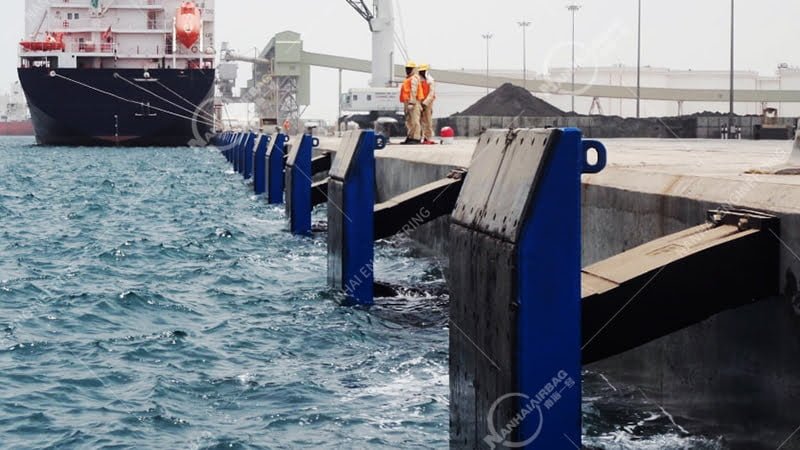Как подкрылки Yokohama поглощают удар?
07/04/2025Характеристики пневматических крыльев в экстремально холодных условиях
07/07/2025Что такое резиновое крыло Element?
Элемент резинового крыла-также известные как модульные, блочные или ножные крылья - представляют собой полностью литой резиновый блок со встроенными монтажными пластинами. Спроектированные в виде колонны, эти морские крылья поглощают кинетическую энергию во время швартовки, защищая как суда, так и причальные сооружения. Они сочетают в себе высокое поглощение энергии, модульная компактная конструкция, и низкая сила реакцииЭто делает их лучшим выбором для корабельных и морских крыльев.

Почему это важно - и быстро
По мере роста мирового морского судоходства порты сталкиваются с проблемой ограниченного пространства и повышенными требованиями к безопасности. Представьте себе балкерный или круизный терминал, где важен каждый миллиметр причала - традиционные крылья могут не подойти. Резиновые крылья Element обеспечивают гибкость, простоту установки и надежную защиту в таких стесненных условиях. Если контейнеровоз смещен от центра или судно типа "ро-ро" встает в док под углом, эти крылья смягчают удары, не повреждая судно или док, защищая дорогостоящую инфраструктуру и предотвращая простои. В условиях растущих затрат на ремонт и сжатых сроков обновление модульных морских крыльев не просто разумно - оно необходимо.
Краткое содержание
Резиновые крылья Element представляют собой полностью литые резиновые блоки колонного типа со встроенными монтажными пластинами, которые поглощают удары при стыковке. Компактная модульная конструкция позволяет устанавливать их как вертикально, так и горизонтально, что делает их идеальным решением в условиях ограниченного пространства.

Как работают крылья Element
При соединении ног каждый элемент сжимается и сгибается под нагрузкой. Специальные составы устойчивы к воздействию ультрафиолета, озона и морской воды, что обеспечивает долговременную работу при минимальном обслуживании.
Размеры варьируются от Высота от 300 до 1 600 мм, а длина варьируется от 500 - 2 000 ммчто позволяет выбрать индивидуальный вариант поглощения энергии в соответствии с особенностями причала. Встраиваемые стальные пластины упрощают вертикальный или горизонтальный монтаж - даже на узких стальных конструкциях.
Почему стоит выбрать резиновое крыло Element от NANHAI?
- Долговечность: Резина, изготовленная методом литья под давлением, противостоит коррозии и разрушению
- Энергетические характеристики: Оптимизированная геометрия обеспечивает высокое соотношение энергии к объему при низкой силе реакции
- Модульность: Комбинируйте блоки в неограниченных конфигурациях, чтобы соответствовать любой планировке спального места
- Не требует особого ухода: Простая установка с помощью болтов и конструкция с центральным расположением болтов снижают риск износа
Области применения резиновых крыльев Element
- Контейнерные и балкерные терминалы
- Ро-ро и круизные терминалы
- Нефть, СПГ и военно-морские доки
- Монопильные платформы и дельфины
Люди также спрашивают
Вопрос 1: В чем разница между элементами и элементами. арка или крылья ячеек?
Модульные и компактные крылья Element идеально подходят для установки в узких местах, в то время как для арочных и сотовых типов часто требуются более крупные лобовые панели.
Вопрос 2: Как происходит поглощение энергии?
Элементные крылья обеспечивают превосходное соотношение энергии к объему, часто превосходя арочные конструкции в компактных системах.
Q3: Можно ли установить резиновое крыло элемента вертикально и горизонтально?
Да, универсальное крепление делает их идеальными для установки за стальной плитой или в ограниченном пространстве.
Вопрос 4: Можно ли настроить размеры?
Absolutely-NANHAI предлагает высоту от От 300 мм до 1 600 ммСтандартные длины от 500 до 2000 мм, а также нестандартные комбинации.
Заключение
Ищете прочное, гибкое и компактное крыло? Независимо от того, управляете ли вы нефтяным терминалом, объектом СПГ или военно-морским доком, резиновые крылья element обеспечивают безопасность и адаптивность, часто по более низкой цене, чем арочные или ячеистые системы крыльев. Если вам нужны надежные, занимающие мало места и обладающие высокими эксплуатационными характеристиками резиновые крылья для вашего порта или судна, контакт НАНХАЙ сегодня - индивидуальные расценки и доставка по всему миру!
